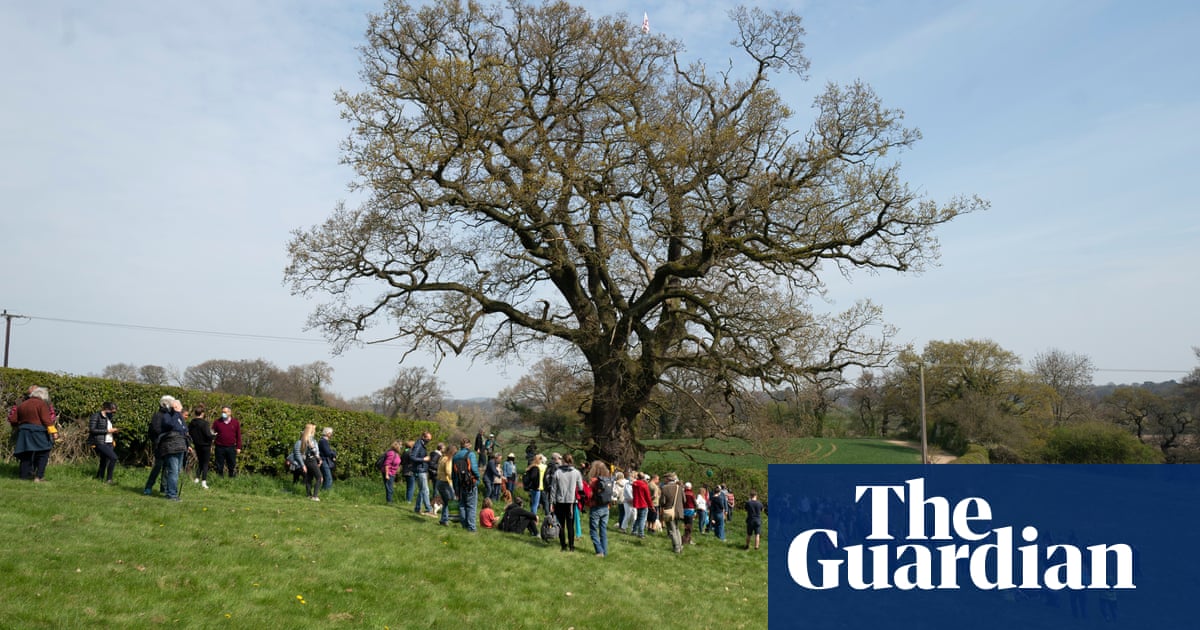
The aim is ambitious: to complete a functioning reconstruction of the extraordinary Sutton Hoo burial ship by 2026 and test it on the river and sea, hopefully providing fresh insight into what life was like in Anglo-Saxon times.
But the project, being run by a small charity, is struggling to source the right sort of British oak to finish the build and is calling for donations, worried that if it does not get the wood from the UK, it may have to look overseas.
The historian Dan Snow is among supporters who has backed the plea for British oak from the Sutton Hoo Ship’s Company, saying it would be a shame if they had to look overseas for wood for such a project.
Described by the British Museum as the most impressive medieval grave to be discovered in Europe, the treasure-filled ship was found in Suffolk in 1939 by Basil Brown, whose story was dramatised in the film The Dig, starring Ralph Fiennes and Carey Mulligan.
Since 2018, the Sutton Hoo Ship’s Company has been piecing together the reconstruction of the seventh-century ship in Woodbridge, Suffolk, with help from more than 150 volunteers and support from the universities of Oxford and Southampton.
It aims to generate new knowledge about Anglo-Saxon times, its craftspeople, warriors, leaders, and seafarers and has brought together historians, archeologists, ship builders and project managers to lend a hand.
But getting the right wood is proving a challenge. The charity does not have the finances to pay commercial prices so is asking for donations and Tim Kirk, the master shipwright for the project, has been travelling across England and Wales looking for suitable trees.
He said: “The problem is that they are veteran trees and quite reasonably people don’t want to cut them down. I understand that and fully respect that but without those trees, we don’t have a ship.
“There must be trees in Britain that are either windblown or struggling with disease or in the way of a new infrastructure project. They must be there somewhere. We just haven’t found them yet.”
Kirk, a professional boatbuilder, said it did not feel right to look abroad. “The major oak forests in Europe now are in France and Denmark and Poland. We really don’t want to get to that stage where we’re looking at foreign timbers.”
The project manager Jacq Barnard said: “There’s just less oak than they would have been in Anglo-Saxon times. We would love it to be built with English wood.”
Snow posted on X: “We need big oak trees to get this awesome vessel on to the water”, adding: “Don’t make them ask the French.”
The historian said it was a “magical project” that reconnected modern Britons with their medieval history. “It’s the stuff dreams are made of. We can learn so much from building these ships – how they can sail, what they can carry, it’s so exciting.”
But he said: “There’s a shortage of the right kind of British oak – or the availability of it.”
The charity has set out on its website specific cuts of wood it needs. For example, it requires long clear runs of oak from trunks 6 metres in length and up to 1.2 metres diameter (at chest height) for planking and other longitudinal timbers. They need to be straight-grained and clear of knots.
It is also after curved timbers up to 4 metres-long for frames, which come either as curved trunks or larger branches from the lower canopy of the tree.
They are also making 60 oars from oak and ash. These need to be of the straightest sections possible, clear of knots and approximately 6 metres long.
The idea is to build a ship based on the understanding of the materials and building methods that would have been used by Anglo-Saxon shipbuilders.
When the ship is completed, sea trialswill test hypotheses such as how the vessel was propelled (by oars and sail), what it could have been used for and where it may have travelled to.
The charity estimates it will use the equivalent of about 12 mature oak trees to build the ship. It has planted 400 oak trees to replace any it uses and so that people in the future will have the correct timber to carry out similar projects.
Discovery of the Sutton Hoo ship
It was one of the most spectacular archaeological discoveries of all time.
In 1939, the landowner Edith Pretty tasked the archeologist Basil Brown to investigate a large Anglo-Saxon burial mound on her land at Sutton Hoo in Suffolk.
He found more, much more, than anyone could have imagined – the richest intact early medieval grave in Europe comprising the ghostly imprint of a 27-metre (86ft) ship with, at its centre, a burial chamber crammed with treasures, dating to the early AD600s.
The find included gold jewellery, Byzantine silverware, a lavish feasting set, luxurious textiles, and military equipment including an enormous shield, a magnificent sword and a helmet wrapped in cloth and laid near the left side of the dead person’s head decorated with images of fighting and dancing warriors.
It clearly commemorated a leading figure of East Anglia, the Anglo-Saxon kingdom and may even have belonged to a king. A popular candidate is Raedwald, who ruled East Anglia and may have held power over neighbouring kingdoms.
Any bodily remains were claimed by the acidic soil and only a human-shaped gap was left among the treasures. Whoever he was, he was probably left-handed as the sword was placed on the person’s right side.
Domestic items were also buried including wooden tubs and buckets, two small cauldrons and one very large one with an intricate iron chain that would have suspended it over a fire.
The burial showed that early Anglo-Saxon England was a place of wonderful craftsmanship and international connections, spanning Europe and beyond and the imagery of cavernous timber halls, sparkling treasures and powerful kings in the Old English poem Beowulf were not fantasy.
Pretty donated the finds to the British Museum and they remain a popular draw, with numbers boosted by the success of the Netflix film The Dig, which dramatised the find.












